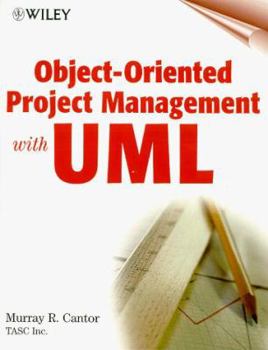Object-Oriented Project Management with UML
Almost all software projects are risky. The goal of every project manager is to somehow deal with the cost and schedule uncertainty while meeting your customer's needs. In Object-Oriented Project... This description may be from another edition of this product.
Format:Hardcover
Language:English
ISBN:0471253030
ISBN13:9780471253037
Release Date:August 1998
Publisher:Wiley
Length:368 Pages
Weight:1.80 lbs.
Dimensions:1.0" x 7.7" x 9.5"
Related Subjects
Client-Server Systems Computer Science Computers Computers & Technology Data in the Enterprise Education & Reference Languages & Tools Mathematics Methodology Networking Object-Oriented Design Object-Oriented Software Design Operating Systems PMP Exam Programming Project Management Science & Math Software Software Design & Engineering Software Design, Testing & Engineering Software Development Software Engineering UMLCustomer Reviews
5 ratings
Good for practicing mgrs
Published by Thriftbooks.com User , 22 years ago
This was very useful for me to get a tactical grip on OO proj mgmt. Has a very good intro and is designed in modules to allow you to read based on your specific role in the group. Always recommend this to customers who are trying to move to iterative development.
A must for project managers
Published by Thriftbooks.com User , 24 years ago
I found this book very useful because it covered UML nicely, and did so in the context of real-world project management scenarios. The book is full of useful tips on how to improve your next PM experience.
A Timely Book for Managers and Sophisticated Customers Alike
Published by Thriftbooks.com User , 24 years ago
Murray Cantor's Object-Oriented Project Management with UML is of value to both the young manager looking for guidance and the seasoned manager looking to ground one's practices. The book is an engaging read that blends best practices with personal opinions. The author is careful to distinguish his personal opinions from the rest of the text and is conscientious to appropriately cite the work of others. Some 70 plus references are listed in the bibliography. In fact, what comes across is Mr. Cantor would prefer software managers to have a repertoire of books on one's shelf. I myself keep returning to Walker Royce's Software Project Management, a Unified Framework, Grady Booch, James Rumbaugh, and Ivar Jacobson's The Unified Modeling Language User Guide, as well as Mr. Cantor's O-O Project Management. Managing great software teams within projects is tough in today's environment of complex solutions, anxious customers, and shrinking time-to-markets. It takes more than just common sense. It requires a game plan and an awareness of when to be flexible. Mr. Cantor lays out a series of methods that focuses on attacking project complexity, leveraging team dynamics, and what needs to be accomplished when in the controlled, iterative development lifecycle. The underlying theme is risk management. Software projects will likely be adventurous for the foreseeable future as we seek ever larger scale systems, but if more engineers and customers were grounded in the techniques espoused by this book a lot more businesses would achieve their goals.
Skillfully written by a front-line practitioner.
Published by Thriftbooks.com User , 25 years ago
This no-nonsense book is a must read for the project manager of large software systems who embraces - or is contemplating embracing - object-based development. Cantor skillfully shares a plethora of knowledge, experience and wisdom for planning, buiding, tracking and delivering your next software product
A thought provoking use of the UML for project management
Published by Thriftbooks.com User , 25 years ago
The UML is an OO notation that has many views. I have been following developments in the UML for about two years now, awaiting the acceptance of the industry. You see, the UML by itself is not a software development methodology. It is simply a collection of notations and views of software development. Dr.Cantor's book takes the UML in the direction of a solid project management methodology by applying a minimal set of OO notations, views and other techniques. The major view in his methodology (and rightfully in my mind) is the use case because it is easily understood by anyone (even your grandmother). Surprisingly, he extends the application of use cases to multiple levels (user, developer, and package) and as a result provides a technique that should actively engage the client throughout the life-cycle of the project. As a practical matter, he ties the use cases back to the design artifacts that OO developers create on their way to writing code. Without these artifacts (class diagrams, sequence diagrams, and methods) and the source code, the use cases are merely documentation. His methodology is well rounded and also minimal. Thus, the project manager does not need to design the entire project to make estimates of effort and time. In addition, it is clear from his real world examples, the simulator case study, and suggestions for project reports, forms, and graphs that he speaks from the experience of having tested his OO methodology on medium and large scale systems. If you are a practicing software developer, a project manager, or a wanabee project manager, or like me, a college instructor, and are interested in learning how to apply OO techniques to project management, this book is for you.




